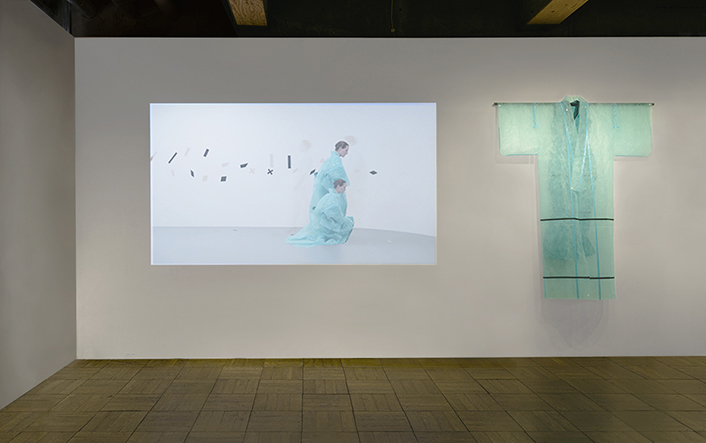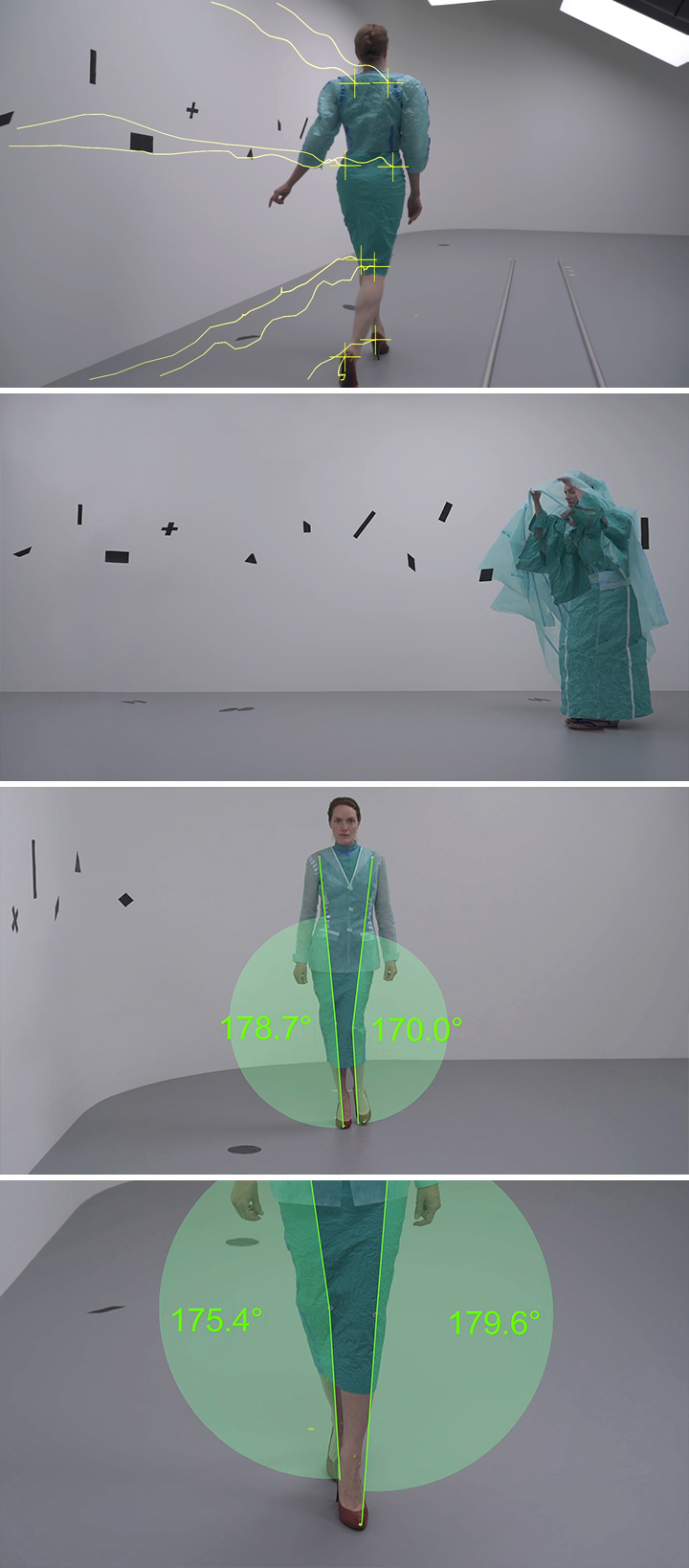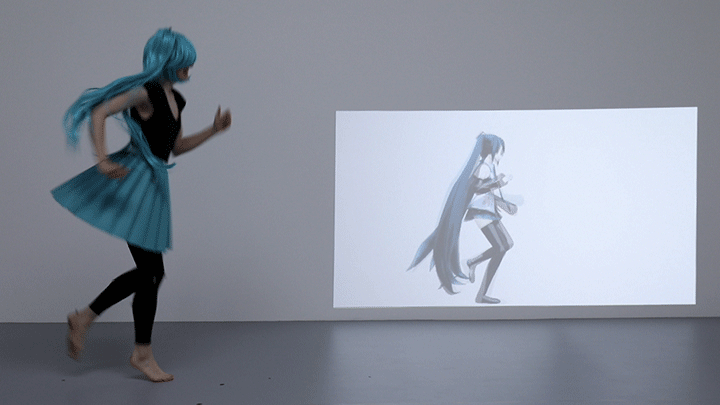WALKING WOMEN
 Walking Women + The Reanimated Archive
Walking Women + The Reanimated Archive
Commissioned by Kyoto D-Lab
Project Direction: Professor Julia Cassim
Kyoto D-lab Designer in Residence Exhibition
by Noam Toran and Marloes ten Bhömer
29 June – Sunday 12 August 2018
Tokyo Gallery
www.d-lab.kit.ac.jp
About the Residency and Exhibition
Kyoto D-Lab’s Designer in Residence Programme invites art and design reasearchers to KIT to develop new signature works in response to the Kyoto Institute of Technology KIT context and the major research themes of KYOTO Design Lab. This exhibition Walking Women + The Reanimated Archive centres on a joint two-month residency by Noam Toran and Marloes ten Bhömer at Kyoto D-Lab.
Walking Women
During her residency at KYOTO Design Lab, Marloes ten Bhömer collated a taxonomy of movement derived from traditional Japanese footwear and its underlying culture. Her research considers the role that design and media play in the social and cultural formation of the Japanese ‘woman in motion.’ The aim is to challenge hardened typologies and stereotypes relating to a woman’s social and physical mobility.
Her focus was classic Japanese cinema and digital characters. Employing motion analysis technology, ten Bhömer highlights the ingrained nature of a woman’s gait and how her movements are affected by such dynamics as learned behaviour and social custom. This research cumultated in the following works: The Path She Walks and Marloes as Miku.
In parallel, she investigated traditional Japanese footwear from a functional design perspective and proposes new approaches to footwear design and production. The aim of the project is not to look at shoes solely as a commercial, cultural or historical object. Rather it is to develop a design methodology that brings practical, technical and material conditions and opportunities to the fore. This research cumultated in the following works: Historic Japanese Footwear Research, Morphologic Chart and Washi Spray-On Shoe Tests. The works are part of ongoing research.

The Path She Walks / 2018
Commissioned by Kyoto D-Lab
Running time: 06:20 min
Project Direction: Professor Julia Cassim
Motion Analysis Supervision: Associate Professor Noriyuki Kida
Studio Supervision: Assistant Professor Yasushi Ichikawa
Motion Analysis: Tomohiro Inoue[KYOTO Design Lab Digital Factory]
Cinematography: Tomohiro Tanaka
Studio Supervision: Shin Yamashita[KYOTO Design Lab Wood Factory]
Soundtrack: Remco de Jong
Special thanks to Noam & Nika Toran, Marine Zorea, Naoko Minami & Kingston University
Awarded: Best Idea award at Copenhagen Fashion Film Festival 2019, a Special Mention at BIDEODROMO International Experimental Film and Video Festival Bilbao 2019 and Best Fashion Short Award at Athens Fashion Film Festival 2020
In The Path She Walks, ten Bhömer investigates female gait in cinema to understand traditional Japanese footwear and the kinematics of gait. Walking and gait in relation to shoes and garments is imbued with learned movements, restrictions and the wearer’s idiosyncratic movements. Walking in cinema embodies other cultural and socio-political elements too, such as the construction of identity, thus making it much richer point of study than a mere technique.
In analysing the films, ten Bhömer found that a focus on a woman’s gait in Japanese and non-Japanese cinema alike often denoted a cinematic metaphor: the female protagonist is or has just undergone a change in the direction of her life. In Kenji Mizoguchi’s The Life of Oharu (1952), for example, the titular character, played by Kinuyo Tanaka, undergoes many dramatic social changes in her life, which are symbolically represented by the sheer volume of walking throughout the film. Ten Bhömer re-enacts a selection of cinematic gait moments and dissects them across cultural, social and anatomic lines. Producing a film which sits between performance art, fashion film and scientific analysis, the footage having been examined with high performance motion software. The Path She Walks reveals the relationship between gait, footwear, clothing, movement, character development and performing identity.
Films cited:
Vertigo -1958 / Dir: Alfred Hitchcock / Actress: Kim Novak
Where Chimneys are Seen - 1953 / Dir: Heinosuke Gosho / Actress: Ranko Hanai and Chieko Seki
Throne Of Blood -1957 / Dir: Akira Kurosawa / Actress: Isuzu Yamada
Life of Oharu -1952 / Dir: Kenji Mizoguchi / Actress: Kinuyo Tanaka
When a Woman Ascends the Stairs -1960 / Dir: Mikio Naruse / Actress: Hideko Takamine
Mars Attacks -1996 / Dir: Tim Burton / Actress: Lisa Marie
Kuroneko (DAUGHTER sequence) -1968 / Dir: Kaneto Shindô / Actress: Kichiemon Nakamura
Kuroneko (MOTHER sequence) -1968 / Dir: Kaneto Shindô / Actress: Nobuko Otowa
 Marloes as Miku / 2018
Marloes as Miku / 2018
Commissioned by Kyoto D-Lab
Project Direction: Professor Julia Cassim
Motion Analysis Supervision: Associate Professor Noriyuki Kida
Studio Supervision: Assistant Professor Yasushi Ichikawa
Marloes as Miku, here presented as gif excerpt, investigates motion-analysis learning methods, software-generated gait and issues of digital identity as it relates to women and mobility. The focus is on the use of MikuMikuDance and MikuMikuMoving: freeware animation programmes that allow users to animate 3D models, originally produced for the Vocaloid character Hatsune Miku. The software makes it possible to animate a model’s gait and generate character types through ambulant movement resulting in a vast collection of video examples, including ‘fails’, that can be found on several online platforms.
In this video work, Marloes ten Bhömer re-enacts a series of Hatsune Miku walking animation cycles sourced from the internet to expose the discrepancy between realistic and computer-aided movement. The work also reveals the acceptance of demeaning presentations of women’s compromised mobility.
The work also addresses motion from a technical perspective and examines movement analysis learning methods. Ten Bhömer employs motion-training techniques to develop a muscle memory for movements, which are decidedly ‘inhuman.’ In traditional motion-capture coaching techniques, the subject leaves their position to passively watch their motion on screen. In contrast, ten Bhömer mimics a dance-training environment by simultaneously watching a video display of the movement to be learned as well as motion-capture footage of herself performing the motion. The next stage in this research will be to test this simultaneous looking, moving and learning in Virtual Reality with potential live muscle feedback.
Washi Spray-On Shoe Tests / 2018
Commissioned by Kyoto D-Lab
Project Direction: Professor Julia Cassim
This was made possible with the generous help of designer and KIT PhD candidate Mika Tsutai.
Footwear tests carried out with washi spray-on paper, a material used commercially in architecture and furnishings composed of mulberry fibre, CMC gels and water. Ten Bhömer generated a series of tests to see how a non-woven spray-on material would behave in shoe production and what technical, material and aesthetic opportunities it might afford.
1. Testing the possibility of customising ad-hoc mould parts for a footwear production technique that doesn’t rely on applying pressure to the last upper.
2. Prefababricated paper folded part, attached to a last with nails, covered in 8 consecutive layers of washispray-on material. The spray-on paper adheres to the pre-folded part, making it an integral piece.
3. Covering a curved surface with a large amount of wet washi material in one go, by producing a surface structure, consisting of nails, for the material to “hold onto”.
4. Borrowing from the Japanese chochin lantern manufacturing technique, a thread is wound around a serrated profile attached to a last. A nylon stocking is placed underneath this construction, creating a surface for the washi material to adhere to during production, which will peel away during de-moulding.
5. Paper confetti is embedded as a means to develop a composite, thereby achieving variations in material properties throughout the surface; an important attribute in footwear.
6. Yarn is imbedded into washi paper in order to develop a composite. The threads reinforce the material, making it more textile-like in places where continual creasing might otherwise produce ripping.
7. Tubes are imbedded into the washi paper to produce a reinforced lacing system.
 Historic Japanese Footwear Research / 2018
Historic Japanese Footwear Research / 2018
& Morphologic Chart / 2018
Commissioned by Kyoto D-Lab
Project Direction: Professor Julia Cassim
Research into traditional Japanese footwear was collated in a morphologic chart. This maps the different functional elements of a shoe from donning methods to enhancing stability and the kinematics of the foot. In order to design a new shoe based on the morphologic chart method, major and minor functional parameters would be analyzed in order to find a parameter or component principle solution not a design solution. In this alternative footwear design methodology, a range of solutions will be integrated into a single design. The chart illustrates that even where footwear is viewed solely from a technical and functional perspective, a shoe can never be understood as that alone.
back to top
________________________________________________________________________________________________________________________
© Marloes ten Bhömer 2000-2023
